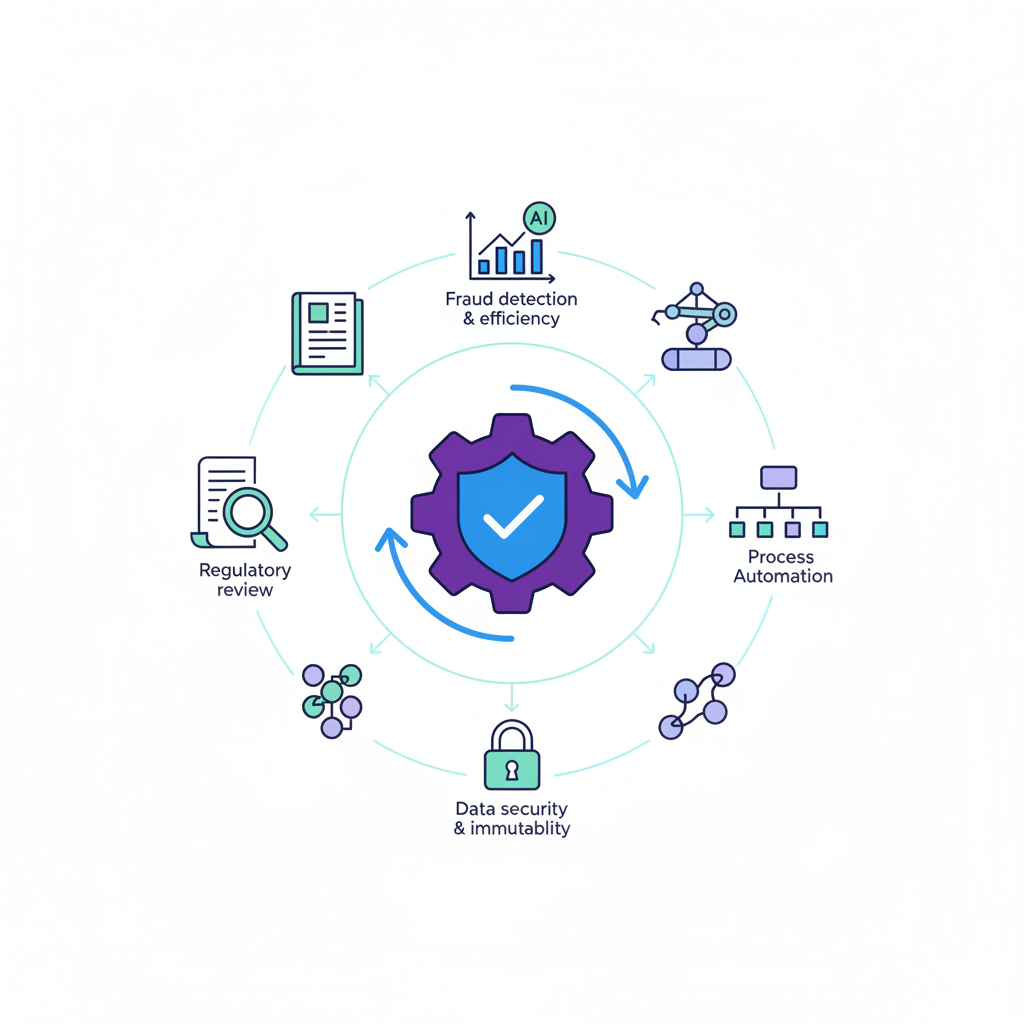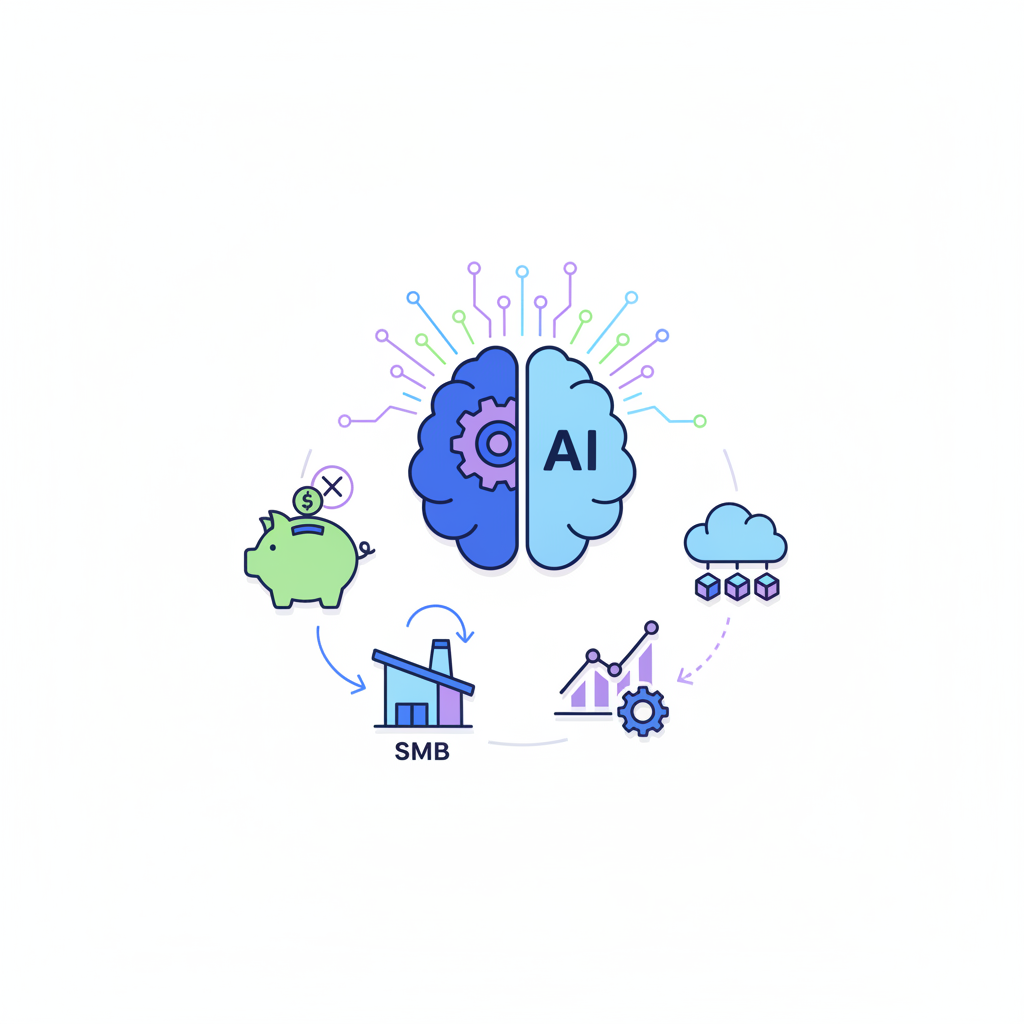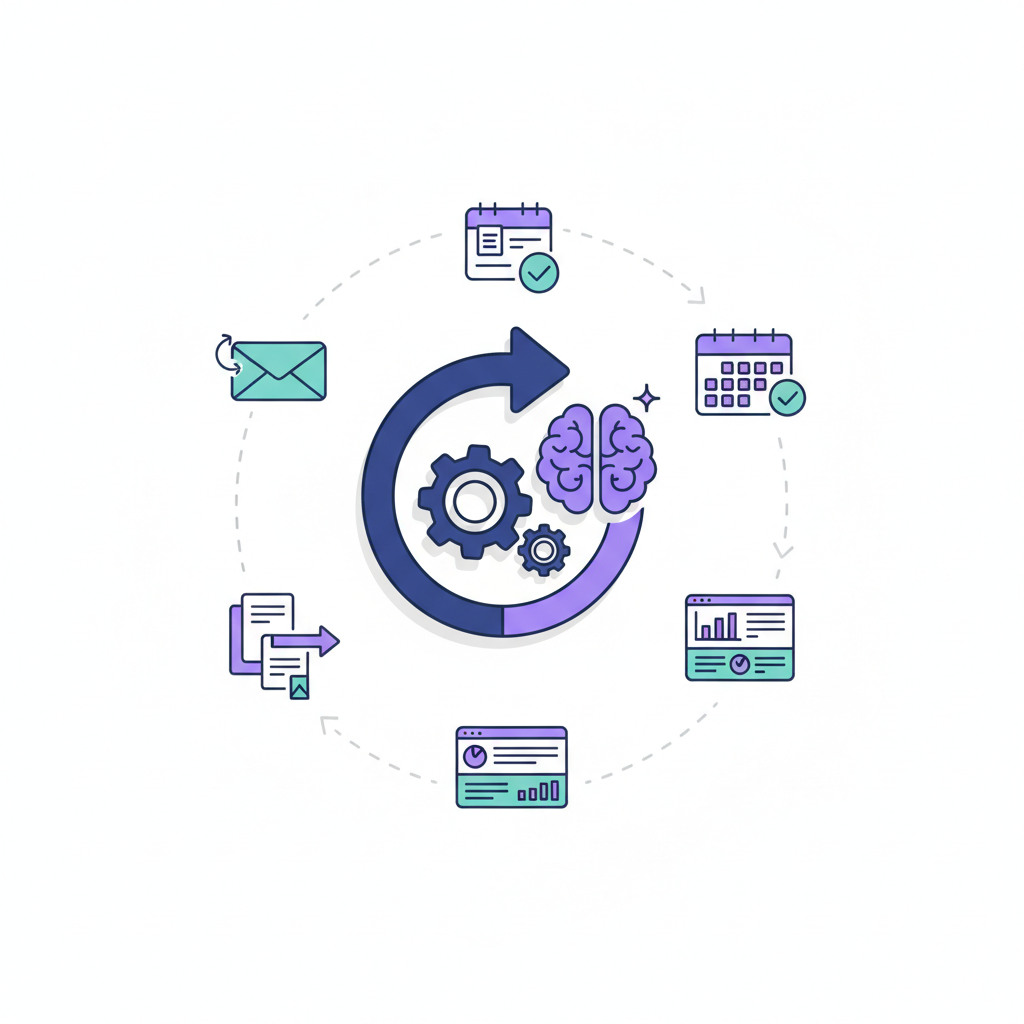AI Tools to Boost Productivity by 10x
Unlock 10x productivity with AI tools like ChatGPT, Claude, and Perplexity. Discover strategies for integration, measurement, and future trends to revolutionize your workflow and achieve exponential efficiency gains.
The relentless pace of modern work often feels like an uphill battle, with constant demands for higher output, faster delivery, and unwavering quality. Professionals across every industry are grappling with overflowing inboxes, endless meetings, and complex projects, all while striving to maintain a semblance of work-life balance. Traditional methods and manual processes are increasingly hitting a ceiling; human capacity alone simply isn't enough to keep up with the escalating expectations of today's dynamic business environment. This is where the true power of artificial intelligence emerges as a transformative force.
Imagine not just incremental improvements, but a radical overhaul of your daily efficiency. This article introduces AI tools as the ultimate game-changer, capable of delivering a staggering 10x productivity boost across various aspects of your professional life. We're not talking about minor tweaks, but a fundamental shift in how work gets done, allowing you to achieve more in less time with greater accuracy. This comprehensive guide will explore what "10x productivity" truly means in the context of AI, delve into practical AI tools for work, and provide actionable strategies for integrating these AI tools for productivity into your workflow. Get ready to unlock unprecedented efficiency and redefine your potential with cutting-edge AI tools.
The '10x' Revolution: Understanding AI's Impact on Productivity
Achieving a "10x productivity" boost might sound like hyperbole, but in the realm of AI, it's becoming an attainable reality. What does it truly mean to achieve a tenfold increase in output or efficiency? It's not merely about working faster; it's about working smarter, leveraging technology to amplify human capabilities to an exponential degree. This means completing tasks that once took days in hours, or generating insights in minutes that previously required weeks of manual analysis. It’s about freeing up significant cognitive load and time, allowing individuals and teams to focus on strategic, high-value activities that drive innovation and growth. AI tools for productivity are fundamentally reshaping our understanding of what’s possible in the workplace.
A core concept driving this revolution is what we can call the '30% Rule for AI'. This principle suggests that AI can automate or augment tasks to save significant time, often exceeding 30% of the manual effort required. While 30% might seem modest, when applied across numerous daily tasks and workflows, these savings compound exponentially, leading to the dramatic gains associated with 10x productivity. For example, if an AI assistant can draft an email in 1 minute that would typically take 5 minutes to compose, that's an 80% time saving on that specific task. When you multiply such savings across dozens of tasks daily, weekly, and monthly, the cumulative effect is profound, leading to substantial improvements in overall work productivity.
How exactly does AI achieve these exponential gains?
- Automation of Repetitive Tasks: One of AI's most immediate impacts is its ability to take over mundane, repetitive, and time-consuming tasks. From data entry and scheduling to report generation and basic customer service queries, AI solutions can handle these operations with speed and accuracy, freeing up human capital for higher-value, creative, and strategic work. This is a cornerstone of automation and productivity AI tools.
- Enhanced Decision-Making: AI-driven insights provide faster, more accurate choices. By analyzing vast datasets in real-time, AI can identify patterns, predict outcomes, and recommend optimal courses of action, empowering professionals to make informed decisions with unprecedented speed and confidence. This significantly boosts AI for efficiency.
- Accelerated Content Creation & Research: AI can drastically cut down the time spent on information synthesis and generation. Whether it's drafting marketing copy, summarizing lengthy documents, or conducting comprehensive literature reviews, AI tools for productivity can generate high-quality content and distill complex information in a fraction of the time it would take a human.
- Personalized Workflows: Advanced AI solutions can adapt to individual needs and preferences, optimizing workflows for personalized performance. By learning from user interactions, AI can proactively suggest tools, resources, or next steps, creating a highly efficient and tailored work environment. This level of customization ensures that AI tools for productivity are not just generic aids, but truly integrated assistants.
Your 10x Productivity Blueprint: Selecting the Right AI Tools
Embarking on the journey to 10x your productivity with AI requires a strategic approach, not just a random adoption of the latest tools. To truly harness the power of AI for business, you need a clear framework for selecting the best AI tools for productivity that align with your specific needs and goals.
Here’s a robust framework for AI tool selection:
- Identify Your Productivity Bottlenecks: Before looking at any tool, pinpoint where you or your team are losing the most time or effort. Are you bogged down by administrative tasks, struggling with content generation, or spending too much time on data analysis? A clear understanding of these pain points will guide your search for productivity tools. For example, if email management is a huge time sink, an AI email assistant would be a high-impact choice.
- Define Your '10x' Goals: What specific outcomes do you want to achieve? Do you aim to reduce report generation time by 80%? Increase content output by fivefold? Improve data analysis accuracy by 50%? Quantifiable goals make it easier to evaluate potential AI tools for work and measure their impact.
- Evaluate Tool Capabilities vs. Needs: Once bottlenecks and goals are clear, research AI tools that specifically address those areas. Match AI features to your challenges. Does the tool offer the specific automation, analytical power, or generative capabilities you require? Look for demos, reviews, and case studies to understand real-world performance.
- Consider Integration & Scalability: How well does the AI tool fit into your existing ecosystem? Seamless integration with your current software (CRM, project management, communication platforms) is crucial to avoid creating new silos. Also, consider its scalability – can it grow with your needs, or will it become a bottleneck as your operations expand?
- Pilot & Measure: Don't commit to a large-scale rollout immediately. Start small with a pilot program. Test the chosen AI tool with a small team or on a specific project. Track results against your defined '10x' goals. Gather feedback, analyze performance, and be prepared to iterate or pivot if necessary. This data-driven approach ensures you're investing in solutions that truly deliver.
Beyond selection, a thoughtful methodology for maximizing gains is essential:
- Start with High-Impact Areas: Focus your initial AI implementation on tasks that consume significant time or resources and where AI can deliver the most immediate and measurable benefits. This creates quick wins and builds momentum for broader adoption.
- Prioritize User Adoption: Tools are only effective if used correctly and consistently. Invest in training and support to ensure your team understands how to leverage the AI tool's full potential. Address concerns, highlight benefits, and foster a culture of experimentation and learning.
- Continuous Learning & Adaptation: The AI landscape evolves rapidly. What's cutting-edge today might be standard tomorrow. Continuously monitor new developments, evaluate emerging AI solutions, and adapt your strategy to stay ahead. Regularly review your AI tools for work to ensure they remain the best fit for your evolving needs. By following this blueprint, you can strategically implement AI to achieve unprecedented levels of productivity.
Top AI Tools for a 10x Productivity Boost: A Segmented Approach
To truly achieve a 10x productivity boost, it's crucial to identify and leverage the right AI tools for specific tasks. Here's a segmented approach to some of the top AI tools for work, designed to supercharge different aspects of your professional life:
AI for 10x Faster Content Creation & Communication:
Generative AI has revolutionized how we approach content. These AI assistants for productivity are invaluable for drafting, brainstorming, and summarizing.
- ChatGPT, Claude, Gemini: These large language models are phenomenal generative AI tools for productivity.
- Crafting Drafts: "Draft a professional email to a client requesting an extension on Project X, due to unforeseen technical issues. Emphasize commitment to quality."
- Brainstorming: "Generate 10 unique blog post ideas about sustainable living for millennials, focusing on actionable tips."
- Summarizing: "Summarize this 5000-word research paper on quantum computing into 5 key bullet points for a non-technical audience."
- Email Generation: "Write a follow-up email to a prospect who showed interest in our SaaS product, offering a personalized demo next week."
- AI Writing Assistants (e.g., Jasper, Copy.ai): These tools go beyond basic generation, specializing in optimizing copy for marketing, sales, and branding. They can generate entire blog posts, social media captions, ad copy, and product descriptions, ensuring brand voice consistency and SEO optimization. They are essential AI software for content teams looking to scale output.
AI for 10x More Efficient Data Analysis & Research:
Navigating vast amounts of information can be a major bottleneck. AI streamlines this process, turning data into actionable insights.
- AI Research Assistants (e.g., Perplexity AI, Elicit): These tools are designed for rapid information synthesis.
- Perplexity AI acts like a conversational search engine, providing direct answers with sources, making literature reviews and quick data extraction incredibly efficient. "Find the latest research on the impact of remote work on employee engagement, citing key studies."
- Elicit focuses on academic research, helping users find relevant papers, extract key findings, and summarize conclusions, drastically cutting down time on scientific literature reviews.
- AI Data Visualization Tools: Tools like Tableau's AI features or specialized AI-driven dashboards can instantly turn complex datasets into clear, interactive visualizations. They identify trends, outliers, and correlations that might take hours or days for a human analyst to uncover, leading to faster, more informed decision-making.
AI for 10x Streamlined Coding & Development:
Developers can significantly boost productivity with AI code assistants.
- AI Code Assistants (e.g., GitHub Copilot): These tools integrate directly into IDEs, offering real-time code suggestions, autocompletion, and even generating entire functions based on comments or existing code. They can also help detect potential bugs and suggest fixes, accelerating the development cycle and improving code quality. This is a prime example of AI tools that boost productivity in technical fields.
AI for 10x Enhanced Design & Multimedia:
Creative professionals can leverage AI to accelerate their workflows.
- AI Image Generators (e.g., Midjourney, DALL-E): These powerful AI software tools allow users to generate high-quality images from text prompts. They are invaluable for rapid prototyping, concept generation, creating unique visual content for marketing, presentations, or even artistic endeavors, drastically reducing the time and cost associated with traditional graphic design. "Generate a photorealistic image of a futuristic city skyline at sunset, with flying cars and lush vertical gardens."
- AI Video Editing Tools: AI can automate mundane editing tasks like cutting silent pauses, generating accurate captions and subtitles, color grading, and even suggesting optimal cuts. Tools like Descript or RunwayML use AI to simplify complex video production, making high-quality video content creation accessible and faster.
This AI tools list represents just a fraction of what's available, but these top AI tools for work demonstrate the immense potential for a 10x productivity leap across diverse professional domains.
Integrating AI for a Synergistic 10x Productivity Ecosystem
Achieving a true 10x productivity boost isn't just about adopting individual AI tools; it's about creating a connected, synergistic AI workflow. The real magic happens when these powerful AI solutions communicate and collaborate, forming an intelligent ecosystem that automates multi-step processes and amplifies overall work productivity.
Beyond Individual Tools: Creating a Connected AI Workflow:
- The Power of API Integrations: Many modern AI tools offer Application Programming Interfaces (APIs) that allow them to connect and interact with existing software. Imagine an AI writing assistant directly publishing content to your CMS, or an AI data analysis tool feeding insights directly into your CRM or project management platform. These integrations eliminate manual data transfer, reduce errors, and ensure a seamless flow of information across your tech stack. This is fundamental to building robust automation and productivity AI tools.
- Automation Platforms (e.g., Zapier, Make.com): These low-code/no-code platforms are the orchestrators of your AI ecosystem. They allow you to create multi-step workflows (Zaps or Scenarios) that connect disparate AI tools and other applications. For example, you could set up a Zap where:
- A new lead in your CRM triggers an AI to draft a personalized welcome email.
- The AI-generated email is then sent via your email marketing platform.
- A summary of the interaction is logged in your project management tool.
Advanced Integration Techniques:
- Custom AI Models: For organizations with unique data or highly specialized needs, developing custom AI models can offer unparalleled advantages. These models are trained on your specific organizational data, allowing for hyper-personalized insights, predictions, and content generation that perfectly align with your business context. This represents a significant investment in AI for business, but the returns in efficiency and competitive advantage can be immense.
- Personalization for Roles & Industries: The way marketing, sales, HR, or product development teams leverage AI will differ. Marketing might use AI for campaign optimization and content generation, while HR could use it for resume screening and personalized onboarding. Customizing AI workflows and tool selections for specific roles and industries ensures maximum impact and relevance, making AI tools that boost productivity truly effective for diverse needs.
Example Workflow: Content Creation from Research to Publication:
Let's illustrate with a practical example of how integrated AI tools can deliver a 10x boost in content creation:
- Research (Perplexity AI/Elicit): A content strategist uses an AI research assistant to quickly gather comprehensive data and insights on a target topic, summarizing key findings in minutes.
- Outline & Draft (ChatGPT/Claude): These summarized insights are fed into a generative AI tool, which then generates a detailed outline and an initial draft of a blog post or article.
- Refinement & Optimization (Jasper/Copy.ai): The draft is then passed to an AI writing assistant to refine the language, optimize for SEO keywords, ensure brand voice consistency, and generate multiple headline options.
- Visuals (Midjourney/DALL-E): Simultaneously, an AI image generator creates unique, high-quality visuals to accompany the content, based on prompts derived from the article's themes.
- Publication (Zapier/Make.com): An automation platform connects the AI writing assistant to the CMS, automatically publishing the optimized article and visuals, and simultaneously scheduling social media promotions drafted by another AI.
This integrated workflow drastically reduces the time from concept to publication, demonstrating the transformative power of a connected AI ecosystem.
Best Practices for Successful AI Adoption:
- Start Small, Scale Gradually: Avoid overwhelming teams with too many new tools at once. Implement AI in manageable phases, allowing users to adapt and gain confidence.
- Training & Upskilling: Empowering users to leverage AI effectively is paramount. Provide comprehensive training, workshops, and resources to help employees understand how to interact with and maximize the benefits of AI tools.
- Data Privacy & Security: As AI tools process sensitive information, ensuring responsible AI use, robust data privacy protocols, and compliance with regulations is non-negotiable. Prioritize tools with strong security features and clear data handling policies.
By strategically integrating AI tools, businesses can build a powerful, intelligent infrastructure that drives unprecedented levels of efficiency and innovation.
Measuring Your 10x Productivity Gains and Overcoming Challenges
Implementing AI tools for productivity is only half the battle; the other half is accurately measuring the impact and addressing the inevitable challenges that arise. Quantifying the "10x" boost is crucial for demonstrating ROI and refining your AI strategy.
Quantifying the '10x': Methods for Tracking Productivity Improvements:
- Time Saved: This is often the most direct measure. Track the hours reduced on specific tasks or processes after AI implementation. For instance, if drafting a report previously took 8 hours and now takes 1 hour with AI assistance, that's a 7-hour saving. Aggregate these savings across teams and projects to see the cumulative impact. This directly reflects AI for efficiency.
- Output Increase: Measure the volume of completed work. This could be the number of articles generated, reports analyzed, lines of code written, customer queries resolved, or marketing campaigns launched. A significant increase in output with AI, without a corresponding increase in human effort, is a clear indicator of enhanced productivity.
- Quality Enhancement: Productivity isn't just about speed; it's also about quality. Measure improvements in accuracy (fewer errors in data entry or reports), better decision-making (higher success rates for AI-informed strategies), or improved customer satisfaction due to faster, more personalized responses. AI tools for productivity can lead to higher quality output with AI.
- ROI Calculation: Ultimately, connect your AI investment to tangible business benefits. Calculate the return on investment by comparing the cost of AI tools and implementation against the monetary value of time saved, increased output, reduced errors, and improved business outcomes. This provides a clear financial justification for your AI strategy.
Addressing Potential Challenges & Learning Curves:
While the benefits of AI are immense, adopting new technologies always comes with hurdles. Proactive planning can mitigate these.
- Initial Setup & Integration Hurdles: Integrating new AI tools with existing systems can be complex. Data migration, API configurations, and workflow adjustments require technical expertise and careful planning. Strategies for smooth onboarding include phased rollouts, dedicated IT support, and leveraging integration platforms like Zapier or Make.com to simplify connections.
- Data Quality & Bias: AI models are only as good as the data they're trained on. Poor data quality (inaccurate, incomplete, or biased data) can lead to flawed outputs and unreliable insights. Establish robust data governance policies, implement data cleaning processes, and regularly audit AI outputs to ensure they are reliable and fair.
- Over-reliance vs. Augmentation: There's a risk of becoming overly reliant on AI, potentially dulling human critical thinking or problem-solving skills. The goal of AI is augmentation, not replacement. Maintain human oversight, encourage critical review of AI outputs, and ensure that AI serves as a powerful assistant rather than an autonomous decision-maker.
- Ethical Considerations: The responsible use of AI in the workplace is paramount. This includes addressing concerns around data privacy, algorithmic bias, job displacement, and transparency in AI decision-making. Develop clear ethical guidelines, ensure compliance with regulations, and foster an open dialogue about the societal impact of AI.
By systematically measuring gains and proactively addressing challenges, organizations can navigate the AI landscape effectively, ensuring that their investment in AI tools for productivity truly translates into a sustainable 10x boost.
The Horizon of Hyper-Productivity: Future Trends in AI Tools
The current wave of AI tools has already demonstrated incredible potential for boosting productivity, but this is merely the beginning. The horizon of hyper-productivity is rapidly approaching, driven by emerging AI technologies that promise even more intuitive, integrated, and autonomous capabilities. Staying informed about these future trends is crucial for any organization looking to maintain a competitive edge and continue leveraging AI tools for productivity.
Emerging AI Technologies: What's next for boosting productivity?
- Hyper-Personalized AI Assistants: Current AI assistants are powerful, but future iterations will be far more intuitive and context-aware. Imagine an AI assistant that not only understands your tasks but also your preferences, working style, emotional state, and even predicts your needs before you articulate them. These AI assistants will seamlessly integrate across all your devices and applications, offering proactive support, personalized learning paths, and highly tailored recommendations, making every interaction incredibly efficient.
- Multi-Modal AI: While today's generative AI excels in text or image generation, the next wave will feature seamless integration of text, image, audio, and video processing. This means an AI could analyze a video meeting, summarize key discussion points, generate action items, draft follow-up emails, and even create visual presentations, all from a single input. This multi-modal capability will unlock unprecedented levels of automation for complex, creative tasks, further enhancing AI software capabilities.
- Autonomous AI Agents: We are moving towards AI agents capable of taking on more complex, end-to-end tasks with minimal human intervention. These agents will be able to plan, execute, and monitor multi-step projects, learning and adapting as they go. For example, an autonomous agent could manage an entire marketing campaign from concept to execution, including market research, content creation, ad placement, and performance analysis, reporting back only on critical deviations or successes. This will redefine work productivity by allowing AI to handle entire workflows.
- Ethical AI & Governance: As AI becomes more pervasive and powerful, the importance of responsible AI development and governance will only grow. Future trends will heavily emphasize explainable AI (XAI), ensuring transparency in how AI makes decisions, and robust frameworks for identifying and mitigating algorithmic bias. Companies will increasingly adopt ethical AI principles to build trust and ensure fair, equitable, and secure use of AI tools.
Preparing for the Next Wave: Staying Ahead in the AI Productivity Curve:
To prepare for this future, organizations must foster a culture of continuous learning and experimentation. Invest in upskilling your workforce to understand and interact with advanced AI systems. Stay abreast of research and development in generative AI and other emerging fields. Most importantly, maintain a flexible and adaptable technology infrastructure that can readily integrate new AI software and solutions. The journey to hyper-productivity is ongoing, and those who embrace continuous innovation will be best positioned to harness the full potential of AI tools for productivity.
Frequently Asked Questions About AI and 10x Productivity
Q: Does ChatGPT actually increase productivity?
A: Absolutely, ChatGPT and similar generative AI tools significantly increase productivity by automating numerous cognitive tasks. For instance, it can draft emails, summarize lengthy documents, brainstorm ideas for projects, generate code snippets, and even assist with language translation or content creation. Users report saving hours each week by offloading initial drafts, research synthesis, and repetitive writing tasks to ChatGPT, allowing them to focus on refinement, strategy, and higher-value creative work. This directly contributes to a boost in productivity.
Q: What is the 30% rule for AI?
A: The '30% rule for AI' is a concept suggesting that AI tools can automate or augment tasks to save a significant portion of manual effort, often exceeding 30%. While a 30% saving on a single task might seem modest, when applied across multiple daily activities, these cumulative savings lead to exponential gains. For example, if AI reduces the time spent on five different tasks by 30% each, the combined effect can easily translate into a 10x increase in overall output or efficiency, freeing up substantial time for more impactful work.
Q: Can small businesses achieve 10x productivity with AI?
A: Yes, absolutely. Small businesses can achieve remarkable productivity gains with AI by strategically adopting accessible and cost-effective AI tools. Many powerful AI solutions are available as SaaS (Software as a Service) products, requiring minimal upfront investment and technical expertise. By identifying key productivity bottlenecks (e.g., customer service, marketing content, data analysis) and implementing targeted AI tools for productivity, small businesses can level the playing field, automate tasks, and scale operations without a massive increase in headcount or resources.
Q: What are the biggest risks of relying on AI for productivity?
A: While AI offers immense benefits, there are several risks. Data privacy and security are paramount concerns, as AI tools often process sensitive information. Over-reliance on AI can lead to a decline in human critical thinking and problem-solving skills if not balanced with human oversight. There's also the risk of algorithmic bias, where AI outputs reflect biases present in the training data, leading to unfair or inaccurate results. Finally, initial integration hurdles and the need for continuous training and adaptation are practical challenges that need to be managed to ensure a smooth transition and effective use of AI tools for productivity.
Embrace the AI Revolution: Your Path to 10x Productivity
The journey to achieving a 10x productivity boost is no longer a futuristic dream but a tangible reality, powered by the transformative capabilities of AI tools. We've explored how these intelligent assistants are fundamentally reshaping the landscape of work, moving us beyond incremental improvements to unprecedented levels of efficiency and output. The '30% rule for AI' illustrates how even seemingly small time savings on individual tasks can compound into exponential gains, freeing up invaluable human capital for strategic, creative, and high-impact endeavors.
Our discussion highlighted the critical importance of strategic selection, emphasizing the need to identify your specific productivity bottlenecks and align them with the best AI tools for work. From generative AI tools like ChatGPT, Claude, and Gemini for content creation, to AI research assistants like Perplexity for data synthesis, and AI code assistants for development, the array of AI tools to boost productivity by 10x is vast and growing. Furthermore, we delved into the power of integration, demonstrating how connecting these tools through APIs and automation platforms creates a synergistic ecosystem that amplifies their individual strengths, leading to truly connected and efficient workflows.
Now is the time to embrace this AI revolution. Start by identifying your biggest time sinks and bottlenecks. Experiment with the AI tools for work discussed, beginning with pilot projects to measure their impact. Invest in training your teams to effectively leverage these powerful technologies, fostering a culture of innovation and continuous learning. The potential for a 10x productivity leap is within your grasp, promising not just more output, but also more meaningful work and a greater capacity for innovation. This is just the beginning of AI's potential, and your proactive engagement today will define your success in the hyper-productive future.
Featured Tools

10Web is an AI-powered WordPress platform that offers automated website building, hosting, and optimization with AI assistance for content and image generation.

An AI-powered assistant that helps users manage and organize their digital information, turning raw data into structured insights.

A global creative platform connecting businesses with freelance designers for custom graphic design projects.

A1.art is an AI art generator that transforms text descriptions into unique digital artworks across various styles.

An AI platform that automates the entire lifecycle of building, deploying, and monitoring custom AI models.
Top AI Categories
Related Articles

AI for financial services: compliance & automation
Discover how AI is revolutionizing financial services through advanced compliance automation, real-time fraud detection, regulatory reporting, and hyper-personalized customer experiences. Explore the future of intelligent, efficient, and secure banking.

How SMBs can adopt AI without big spending
Discover how small and medium businesses can adopt AI affordably. This practical guide covers low-cost tools, quick wins, real-world examples, and step-by-step strategies to integrate AI without breaking the bank.

Top 10 AI tools for Enterprise Workflow Automation
Enterprises are turning to AI-powered workflow automation to eliminate manual processes, cut costs, and accelerate strategic execution. Unlike traditional automation, AI can handle unstructured data and make intelligent decisions, offering profound benefits across finance, HR, and IT. This guide curates the top 10 AI tools—from RPA leaders like UiPath and Automation Anywhere to iPaaS solutions like Workato and low-code platforms like Microsoft Power Automate—providing a blueprint for building a more agile and resilient organization.